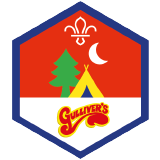
Tree switch
Love trees?
If you want to take your love of trees further, why not check out our partnership with the Green Tree Badge. This will give you the opportunity to engage with trees in a new way and earn external badges along the way!
Green Tree BadgeBefore you begin
- Plan to visit a park, wood, or common. It should be somewhere that has a good selection of trees; ideally, at least three or four different types.
- This would be a great game to play at camp, but doesn’t work so well in winter as trees are easier to identify when there are leaves on them.
- Invite parents and carers to help.
- Download the Leaf ID sheet to help you identify trees and print enough copies (one between two is ideal).
Play the game
- The person leading the game should give out the ‘Leaf ID’ sheets. Everyone should travel safely together to the place they’ll play the game, spotting leaves on the way. If they find any that aren’t on the sheet, then someone could take a photo of a leaf to identify later on.
- When everyone arrives at the place they’ll play the game, the person leading the game should explain which trees are included in the game, and where the boundaries are.
- Everyone should help identify the trees that are included in the game, using their ‘Leaf ID’ sheets.
- Choose one person to be the tree caller.
- The player leading the game should divide all of the other players between the trees in the game. They should divide people evenly, so the same number of people are touching each tree.
- The tree caller should stand in the middle of the tree area. They should call out the name of a tree. Everyone touching that type of tree should leave their home tree and run to another tree of the same type.
- While the players are running, the tree caller should try to find a free space on a tree in the game.
- If the tree caller finds a space, the person who’s left without a free space becomes the tree caller. If the tree caller doesn’t find a space, they stay as the tree caller.
- Whoever is the tree caller should keep repeating steps six to eight until it’s time to finish the game.
Reflection
This activity was a chance to value the outdoors. Sit and look at the trees. Everyone should notice their shapes, bark, leaves, and branches; all of the trees are different! Why are trees so important? People may think about how they help us breathe by acting like natural air purifiers, how they’re a home for birds, animals, and insects, and how fallen leaves act as a natural compost for the forest floor. If they want to, people could thank the trees before they head back to their meeting place. How might people thank the trees? Some people may say ‘thank you’ and others may give them a hug.
This activity also needed everyone to be active. People will probably need a rest after such an energetic game. The game was about having fun while getting a bit of exercise too. Does everyone feel tired? It’s good to find exercise that you enjoy – did you enjoy the risk and competition in this game?
Safety
All activities must be safely managed. You must complete a thorough risk assessment and take appropriate steps to reduce risk. Use the safety checklist to help you plan and risk assess your activity. Always get approval for the activity, and have suitable supervision and an InTouch process.
- Outdoor activities
You must have permission to use the location. Always check the weather forecast, and inform parents and carers of any change in venue.
Use as many kinds of trees as you can, especially if there are lots in your local area. Make sure everyone understands each step of the game before you move on.
Make sure the playing area is accessible to everyone.
All Scout activities should be inclusive and accessible.
Why not combine the game with a longer walk or hike around the area to spot more trees?
People can take it in turns to lead the game.

